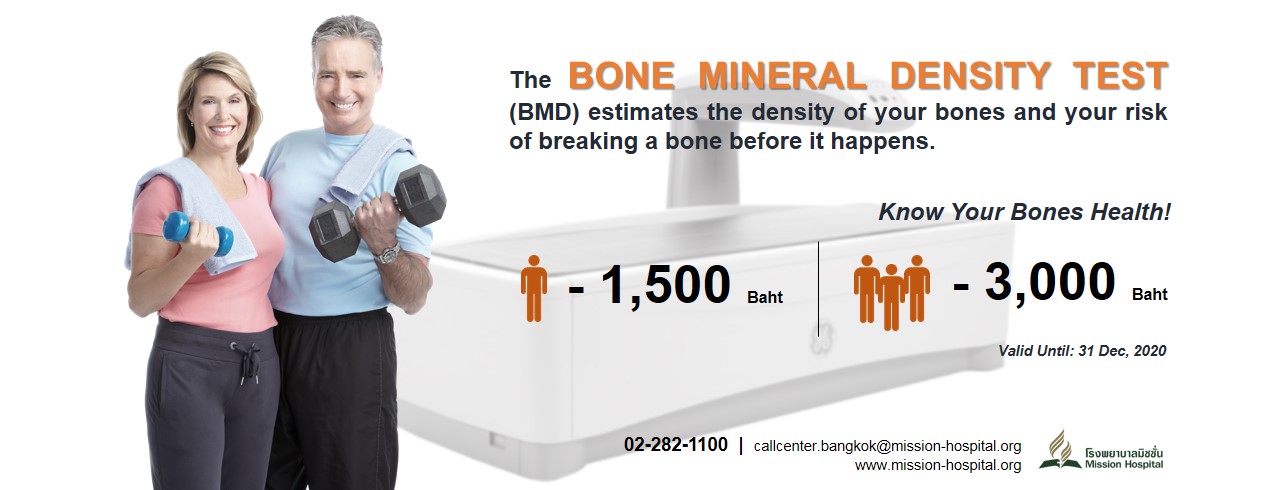Bone Mineral Density

What is BMD Test?
BMD test is a quick and painless process of measuring the calcium and minerals in a part of the bone using the X-Rays.
What does the test do?
A BMD test does to measure your bone mineral density. It estimates how dense or thick your bones are. It is a test provides a snapshot of yore bone health.
- The test identify osteoporosis,
- The test determine the risk for bone fractures (broken bone),
- The test measures your response to osteoporosis treatment.
Why do I Need to do BMD Test?
BMD (Bone Mineral Density) Test detects the possibility of osteoporosis, which is the condition of how the bones get weak and thin and become more likely to break. It is a silent condition, which means you don’t feel any symptoms. So without a BMD test, you may not realize you have osteoporosis until you break a bone. Therefore doing BMD test is why very important to detect any bone condition as earlier as possible.
What are the types of BMD Test?
There are 2 types of BMD tests done.
Type 1: Central DXA Test:
Central DXA stands for Dual Energy X-ray Absorptiometry. This test looks at the spine and hip bones. It tends to be more accurate and costs more. During the test, the candidate lie down on a padded platform fully clothed. A machine arm passes above your, sending low-dose X-rays through the body. This test lasts about 10 minutes. Based on how much the X-rays change after passing through your bones, it comes up with an image of your skeleton. The image is given to an expert who reads the results.
Type 2: Peripheral Test:
This measures bone density at your wrist, finger and heel. The test is less thorough because it doesn’t examine your hips or spine. It is usually cheaper.
It is a portable device for screening which can be done at health fairs or to a larger group of people to make the test available who may not be able to get the central DXA test.
How to understand my BMD Test Result?
There are 2 type of scores after the bone density test is done. T-Score and Z-Score.
T-Score:
T-Score compares your bone density with a healthy, young adult of your gender. The score indicates if your bone density is normal, below normal or at the levels that indicate osteoporosis.
|
Result |
Result Level |
Definition |
|
Normal |
(-1 and Above) |
BMD is normal |
|
Low Bone Mass |
(-1 to -2.5) |
BMD is low and may lead to Osteoporosis |
|
Osteoporosis |
(-2.5 and Above) |
Osteoporosis |
Z-Score:
Z-score below -2.0 means that you have less bone mass than someone your age and that it could be caused by something other than aging.
Who should get BMD tested?
Prevention is always better than cure. Therefore, you should discuss with the doctor whether BMD test needed to be done or not. And the common recommendation for conducting the test if any of the criteria is met:
- A woman with age 65 or older,
- Postmenopausal woman age 50 or older,
- Woman at the age of menopause and have a high chance for breaking bone,
- Woman who has already been through menopause, younger than 65, and have other things that give you a higher chance of osteoporosis,
- Man age 50 or older with other risk factors,
- You break a bone after age 50 years old.
- You have lost more than 1.5 inches of your adult height,
- Your posture has gotten more hunched,
- Having back pain without any cause,
- Your periods hoe stopped or are irregular although you’re neither pregnant or menopausal,
- You have gotten an organ transplant,
- You have had a drop or hormone levels,
- You have taken some types of prescription drugs, which can cause bone loss.
How often should I get tested?
- If you are diagnosed with osteoporosis and taking medication, you may be expected to have a bone density test every 1-2 years.
- Even if you don’t have osteoporosis, the doctor may suggest you to get a bone density test every 2 years, especially for women during or after menopause.

Appointment and Inquires
Tel: (+662) 282-1100
Fax: (+662)280-0441
Email: This email address is being protected from spambots. You need JavaScript enabled to view it.
Website: www.mission-hospital.org



